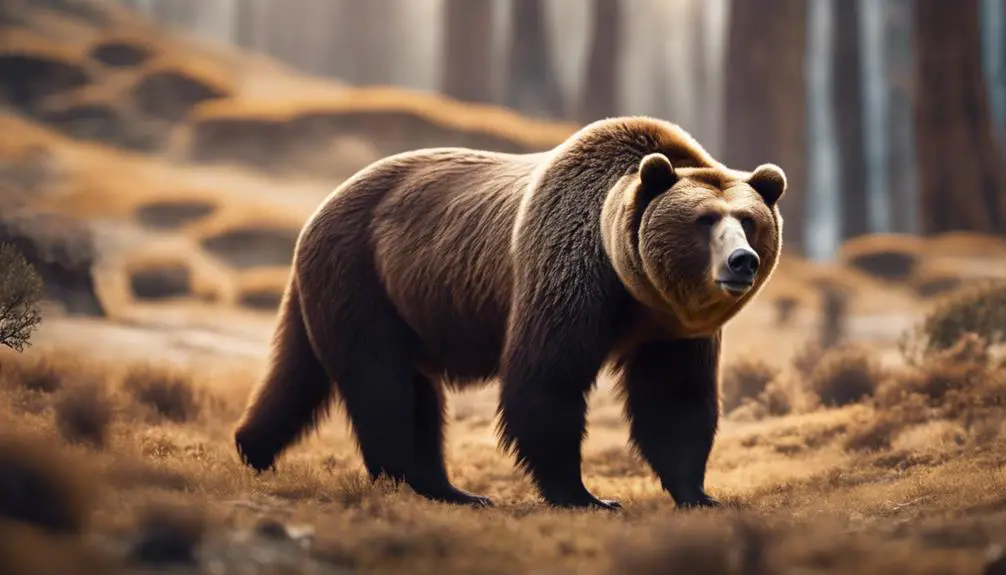Discover 15 fascinating brown animals worldwide, like the adaptable Brown Bear and the unique Brown Kiwi in New Zealand. From the versatile Brown Trout blending in clear streams to the resilient Bush Pig thriving in African landscapes, each creature plays a crucial role in its ecosystem. Uncover the rich diversity and extraordinary adaptations these animals exhibit, hinting at the intricate web of life they are part of. Embrace the beauty and significance of these brown animals, showcasing their strength, resilience, and importance in the natural world. Explore their world and appreciate the wonders they bring to our planet.
Brown Bear
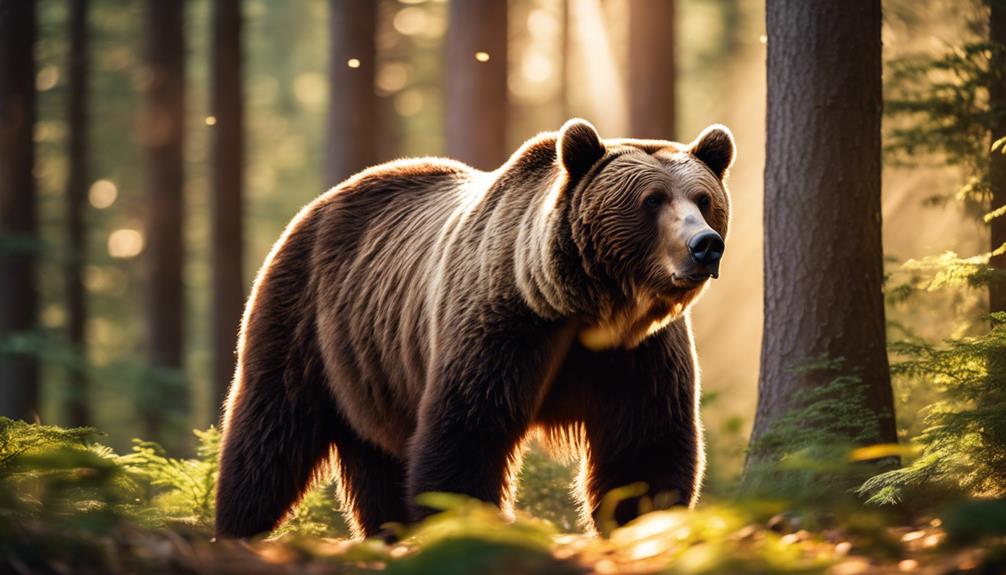
Inhabiting diverse ecosystems across the world, the Brown Bear is a majestic and iconic species known for its strength and adaptability. These powerful creatures have a significant presence in various habitats, ranging from dense forests to open meadows. Their brown fur provides excellent camouflage, blending seamlessly with their surroundings. Brown Bears play important roles in maintaining ecosystem balance, controlling populations of other species, and shaping vegetation through their foraging activities. Their adaptability allows them to thrive in changing environments, utilizing adaptations for thermal regulation and reproduction to guarantee survival.
When encountering a Brown Bear in the wild, it’s essential to remember their importance in the ecosystem and to respect their space. Observing these magnificent creatures from a safe distance not only ensures your safety but also contributes to their well-being. By appreciating the beauty and strength of Brown Bears, you can develop a deeper understanding of the intricate web of life in which they play a significant role.
Bongo Antelope
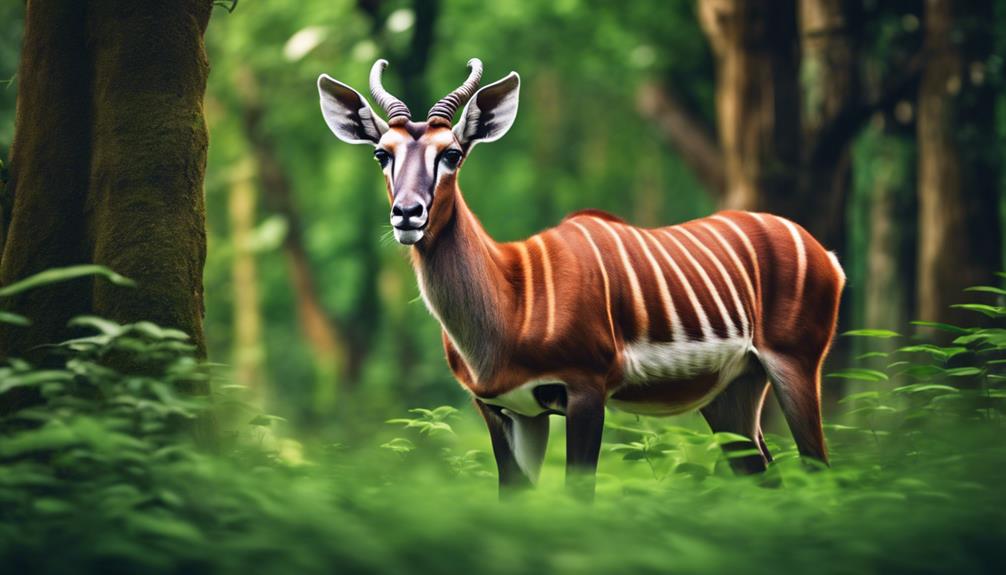
The Bongo Antelope, with its distinctive spiral horns and striking reddish-brown coat, is a fascinating species found in the lush forests of Central Africa. These majestic animals are known for their beautiful coat that helps them blend seamlessly into the dense vegetation of their habitat, providing them with excellent camouflage against predators. The Bongo Antelope’s large, spiral horns aren’t only impressive in appearance but also serve as a means of defense and for establishing dominance within their herds.
As herbivores, Bongo Antelopes play an important role in shaping the biodiversity of their ecosystem through seed dispersal and vegetation control. Their presence helps maintain the delicate balance of the forest ecosystem by influencing plant growth and population dynamics.
Conservation efforts are vital to protect these magnificent creatures from threats such as habitat loss and poaching. By safeguarding their habitat and raising awareness about the significance of preserving biodiversity, we can guarantee a sustainable future for the Bongo Antelope in Central Africa’s forests.
Brown Trout
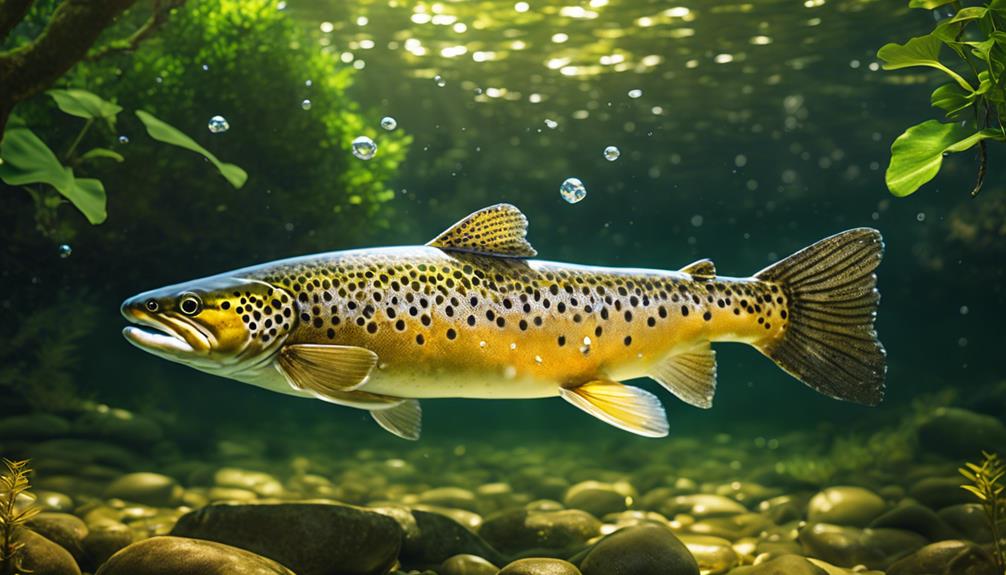
To explore the aquatic domain, consider the enchanting world of the Brown Trout. You’ll find these fish in clear, cold streams and rivers, showcasing a beautiful mottled brown coloration that aids in blending with their surroundings. Brown Trout are known for their adaptability, thriving in various water conditions and ecosystems. They’re prized by anglers for their elusive nature and strong fights when hooked.
These trout have a varied diet, feeding on insects, small fish, and crustaceans. Their ability to adjust their feeding habits based on food availability is remarkable. During spawning season, male Brown Trout develop a vibrant coloration and distinctive jaw structure, attracting females for reproduction.
Conservation efforts play an important role in protecting Brown Trout populations from habitat degradation and overfishing. By understanding their habitat requirements and implementing sustainable fishing practices, we can ensure the continued presence of these iconic brown fish in our waterways.
Bush Pig
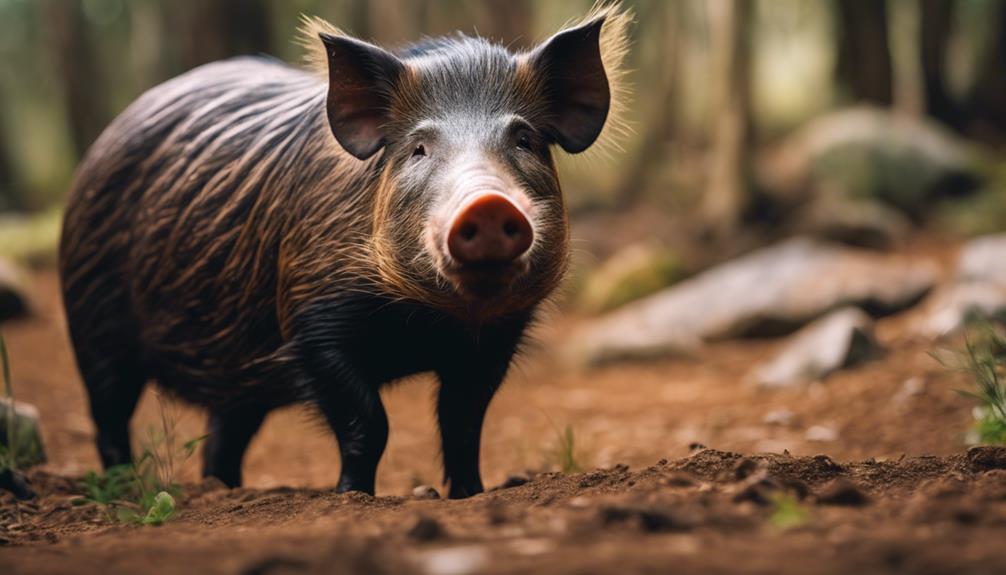
Thriving in various African ecosystems, the Bush Pig exhibits a distinct presence with its rugged appearance and adaptable nature. As you observe these creatures in their natural habitat, you’ll notice their strong build and coarse, dark brown fur that provides effective camouflage among the dense vegetation.
Bush Pigs are known for their omnivorous diet, feeding on roots, fruits, insects, and even small animals, showcasing their adaptability to various food sources in changing environments. Their keen sense of smell and ability to root through the forest floor make them important contributors to ecosystem dynamics.
Despite their solitary nature, Bush Pigs play a crucial role in seed dispersal and soil aeration, influencing plant regeneration and overall habitat health. Their resilience in facing habitat loss and human encroachment highlights the importance of conservation efforts in preserving these unique brown animals.
With their tenacity and resourcefulness, Bush Pigs symbolize the adaptability and survival instincts necessary for thriving in diverse ecosystems.
Brown Thrasher
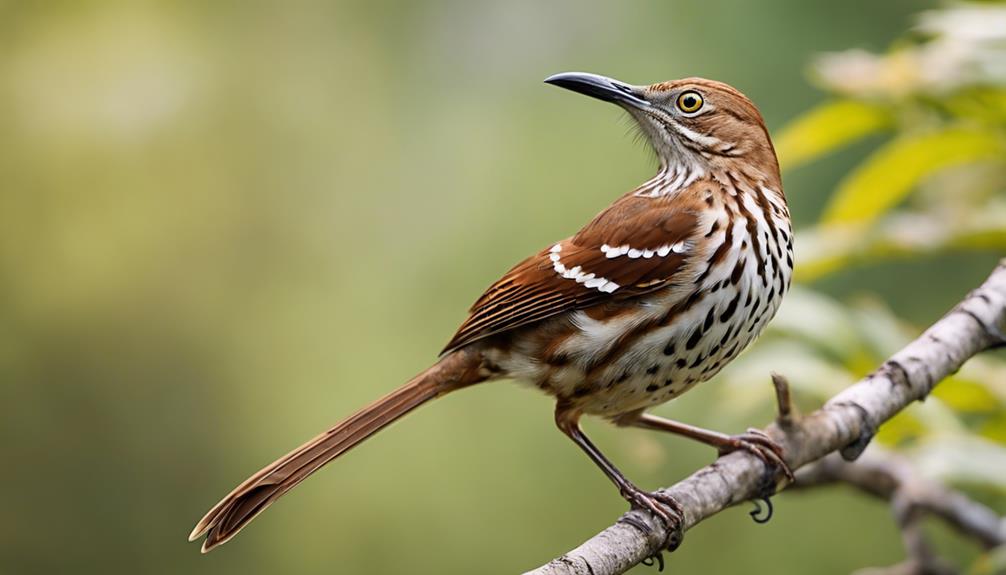
Discover the fascinating habits and unique characteristics of the Brown Thrasher, a versatile bird species found in various North American habitats. Known for its rich brown plumage with streaks of white and rufous, the Brown Thrasher is a skilled mimic and can imitate the songs of other birds.
These birds are mainly ground foragers, using their long, curved bills to flip leaves and debris in search of insects, spiders, and small vertebrates. Their diverse diet also includes fruits, seeds, and nuts, making them important contributors to seed dispersal in their ecosystems.
During the breeding season, male Brown Thrashers perform elaborate song displays to attract mates and establish territories. They build cup-shaped nests in dense shrubs or low trees, where females lay their eggs. Both parents take turns incubating the eggs and feeding the chicks once they hatch.
Despite facing threats such as habitat loss and nest predation, Brown Thrashers continue to thrive in a variety of habitats, showcasing their adaptability and resilience as crucial members of North American bird communities.
Brown Hyena
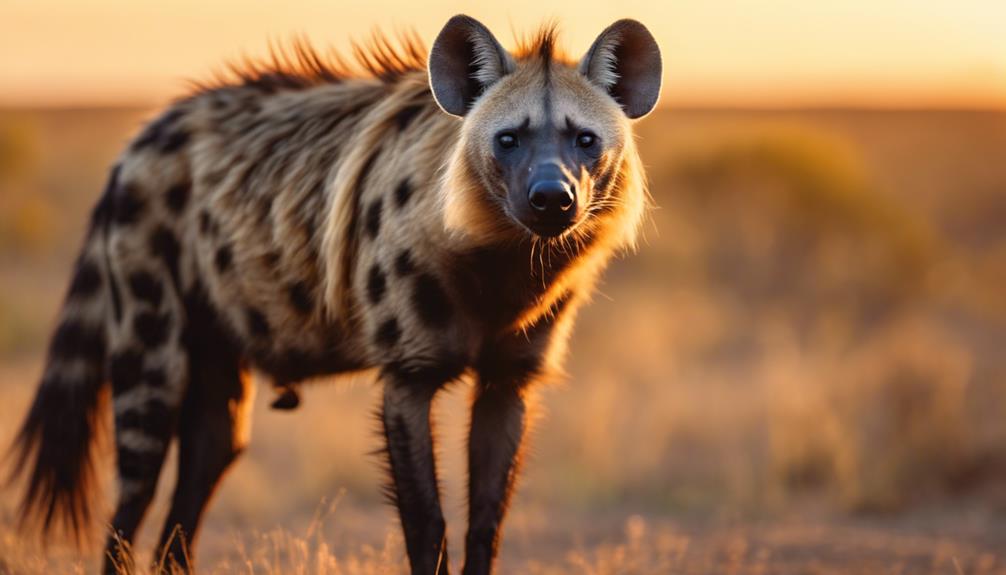
The distinctive brown hyena, with its shaggy fur and unique behaviors, plays an important role in its African ecosystem. As a scavenger, you contribute to the ecosystem by cleaning up carcasses left behind by other predators. Your keen sense of smell helps locate food over long distances, making you efficient at finding resources in the arid landscapes you inhabit. Despite your solitary nature, you sometimes form small groups to cooperate during hunts or when defending territories.
Your sandy brown coat provides excellent camouflage in the savannas and deserts where you roam, allowing you to blend seamlessly with the surroundings while avoiding potential threats. Known for your distinctive whooping calls that echo through the night, you communicate with other hyenas in your clan, establishing social bonds and reinforcing group cohesion. Your adaptability to harsh conditions and your role as a scavenger are essential for maintaining the balance of the African ecosystem.
Brown Lemur
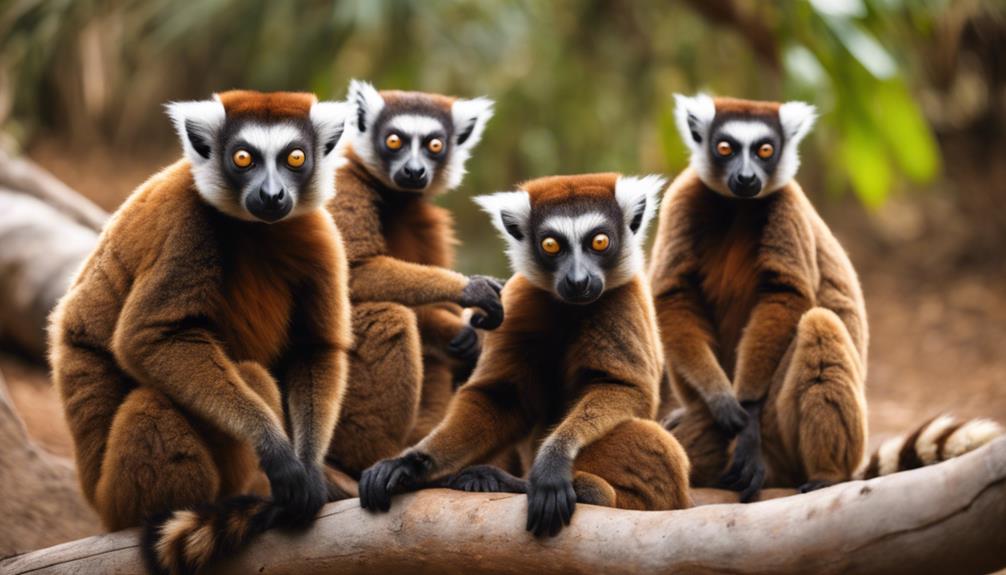
With its distinctive reddish-brown fur and lively demeanor, the Brown Lemur captivates observers with its playful antics in the lush forests of Madagascar. These agile primates, known for their social nature, spend much of their time leaping between trees and foraging for fruits, leaves, and flowers. The Brown Lemur’s fur provides excellent camouflage among the trees, helping them evade predators like fossas and hawks.
These lemurs live in large groups, led by dominant females, and engage in grooming rituals to strengthen social bonds. Males often display dominance through vocalizations and physical posturing. The Brown Lemur’s role in seed dispersal is crucial for maintaining the biodiversity of Madagascar’s ecosystems.
However, habitat destruction and hunting threaten the survival of these charismatic primates. Conservation efforts aim to protect their natural habitats and raise awareness about the importance of preserving Madagascar’s unique biodiversity. By supporting conservation initiatives and sustainable practices, you can help ensure a bright future for the Brown Lemur and its habitat.
Brown Agouti
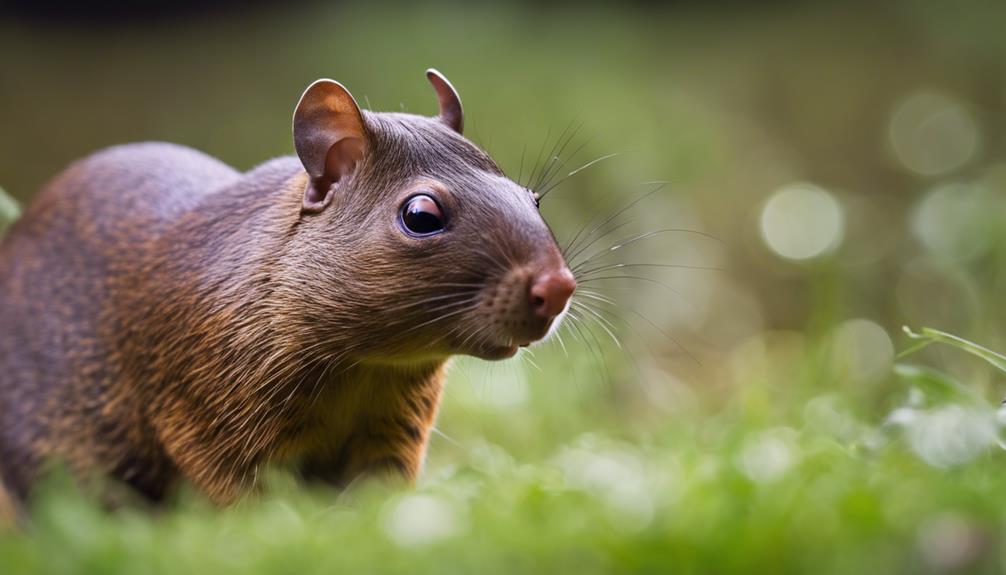
Inhabiting the diverse ecosystems of Central and South America, the Brown Agouti is a fascinating rodent species known for its efficient foraging habits and distinctive reddish-brown fur. These agile creatures play a crucial role in seed dispersal, helping to maintain the balance of their habitats. With their keen senses and nimble movements, Brown Agoutis navigate the forest floor with ease, foraging for fruits, nuts, and seeds while remaining vigilant against predators.
Their reddish-brown fur provides effective camouflage among the dense vegetation, allowing them to blend seamlessly into their surroundings. Brown Agoutis are known for their resourcefulness in finding food sources and storing them for later consumption. Their adaptability to various environments and ability to thrive in changing conditions make them resilient members of their ecosystems.
Observing Brown Agoutis in their natural habitat offers a glimpse into the intricate interplay between these rodents and the diverse flora and fauna around them. Studying their behaviors and ecological interactions sheds light on the importance of preserving the rich biodiversity of Central and South American ecosystems.
Brown Capuchin
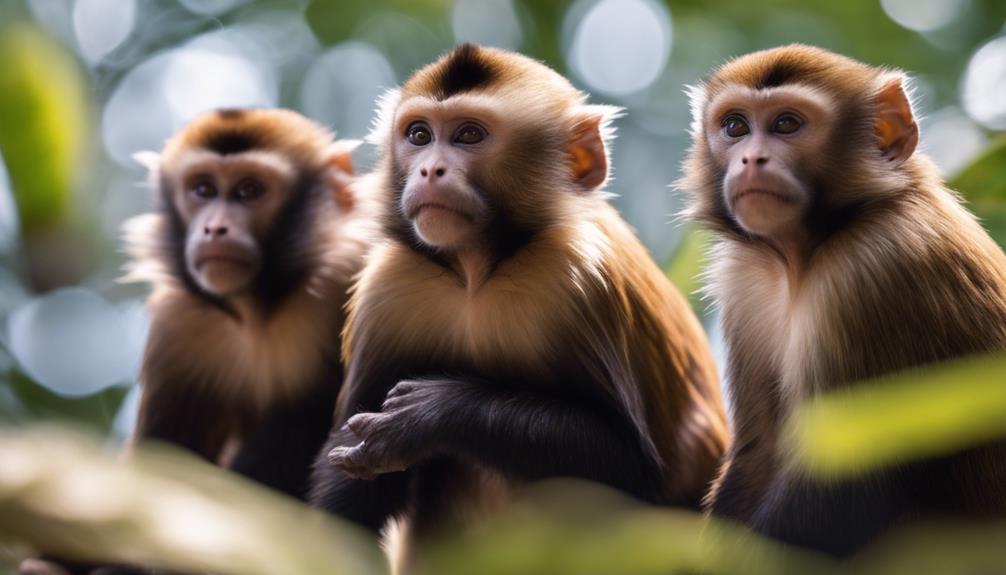
Nimble and intelligent, the Brown Capuchin monkeys display remarkable problem-solving skills in their natural habitat. These agile primates are known for their dexterous hands, which they use to manipulate objects and forage for food. Living in the lush rainforests of South America, Brown Capuchins play an important role in seed dispersal, helping maintain the diversity of plant species in their ecosystem.
With their keen sense of observation and social intelligence, Brown Capuchins engage in complex social interactions within their troops. They communicate using various vocalizations and body language, fostering strong bonds and hierarchical structures essential for their survival. Their brown fur provides effective camouflage among the trees, aiding in evading predators and hunting for insects, fruits, and small animals.
As an integral part of the rainforest ecosystem, Brown Capuchins contribute to the overall health and balance of their environment. Understanding and protecting these intelligent primates is essential for preserving the biodiversity of their habitats and ensuring the sustainability of the delicate ecosystems they inhabit.
Brown Booby
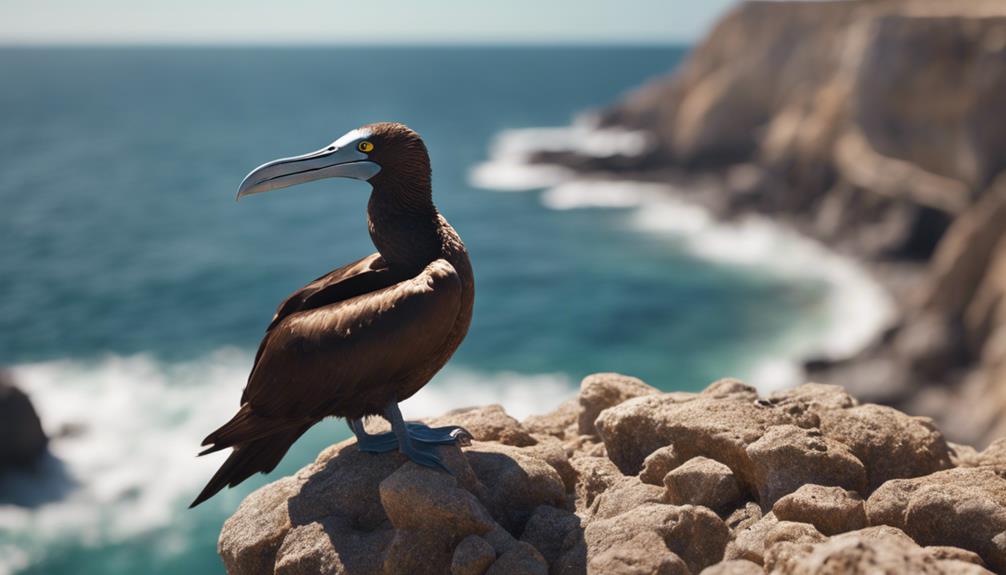
Moving on from the Brown Capuchin monkeys, let’s shift our focus to the Brown Booby, a fascinating seabird known for its distinctive brown and white plumage. These birds are skilled hunters, diving from impressive heights into the ocean to catch fish with remarkable precision. With their long, pointed bills and streamlined bodies, Brown Boobies are perfectly adapted for their oceanic lifestyle.
Brown Boobies can be found in tropical and subtropical regions across the globe, nesting in colonies on remote islands. Their brown plumage provides excellent camouflage against the rocky shorelines where they often build their nests. These seabirds are highly social creatures, engaging in elaborate courtship displays and forming strong bonds with their mates.
In addition to their remarkable diving abilities and striking appearance, Brown Boobies play an important role in marine ecosystems by controlling fish populations and recycling nutrients. By balancing the marine food web, these birds contribute to the overall health and stability of coastal ecosystems.
Brown Pelican
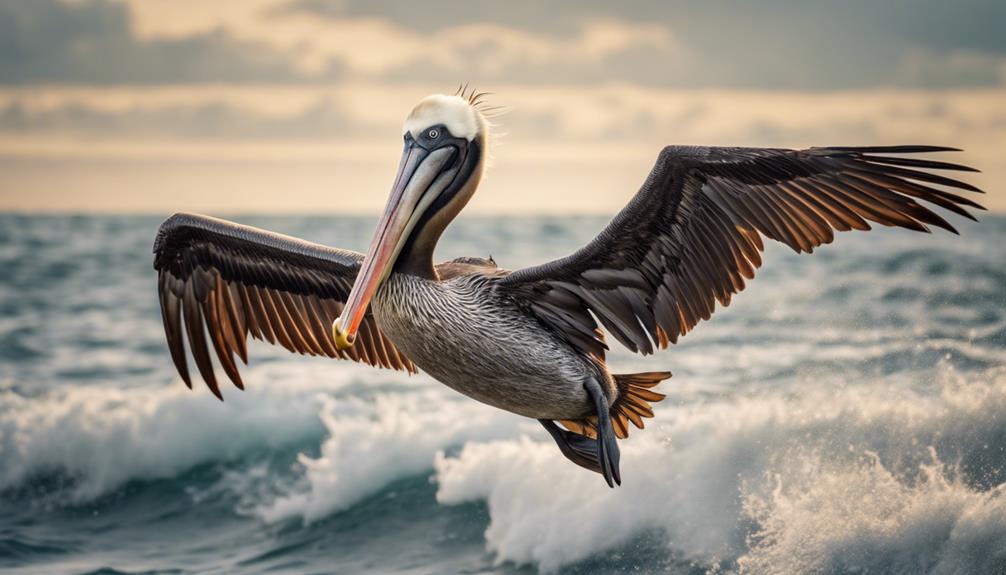
Found along the coastlines of the Americas, the Brown Pelican is a distinctive seabird known for its unique diving abilities and characteristic pouch. These pelicans are easily recognizable by their dark brown plumage, contrasting with a lighter head and neck. Their most remarkable feature is the expandable throat pouch used for scooping up fish while diving from impressive heights into the water.
Brown Pelicans primarily feed on fish, using their keen eyesight to spot prey from above before plunging into the ocean to catch their meal. These birds are highly skilled divers, using gravity to propel themselves underwater with precision. Their long bills and stretchy pouches aid in catching fish, making them efficient hunters in their marine habitats.
Brown Pelicans are also social creatures, often seen in groups perched on rocks or flying in formation along the coastline. Their presence is a delightful sight for nature enthusiasts and beachgoers alike.
Brown Rat
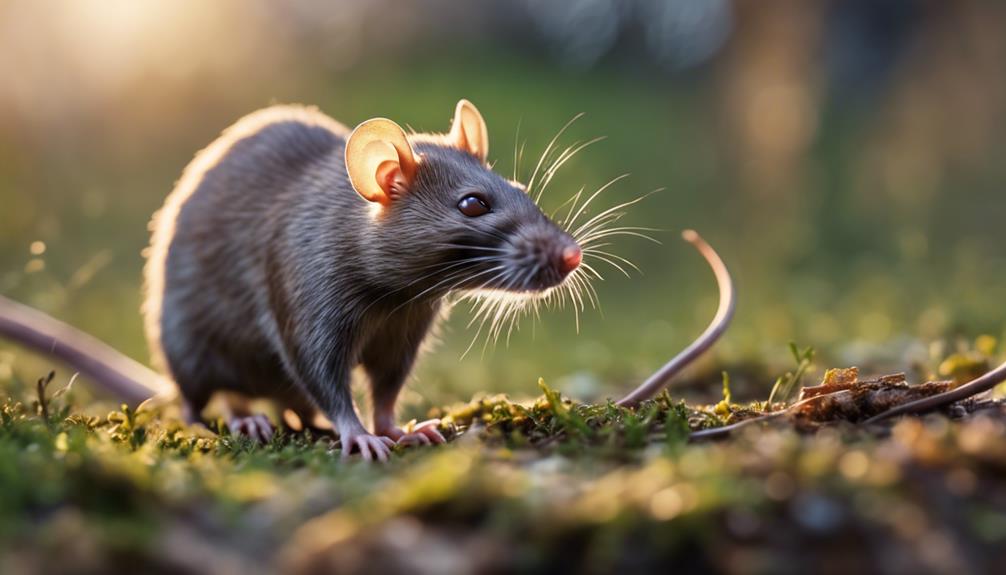
The ubiquitous Brown Rat, known for its adaptability and resilience, plays a significant role in urban ecosystems worldwide. These intelligent rodents are adept at finding food sources and shelter in human environments, often coexisting alongside humans in cities and towns. Brown Rats, with their brown fur providing camouflage in urban settings, are prolific breeders, capable of quickly establishing large populations.
Their scavenging behavior helps in waste removal, while also posing challenges in managing pest control. Despite being common and often considered pests, Brown Rats have unique social structures within their colonies, displaying complex communication and cooperative behaviors. Their presence influences the dynamics of urban wildlife, impacting local biodiversity and ecosystem balance.
As opportunistic omnivores, Brown Rats adapt well to various diets, further contributing to their survival in changing environments. Understanding their behaviors and ecological roles is essential for effective urban wildlife management and conservation efforts.
Brown Recluse Spider
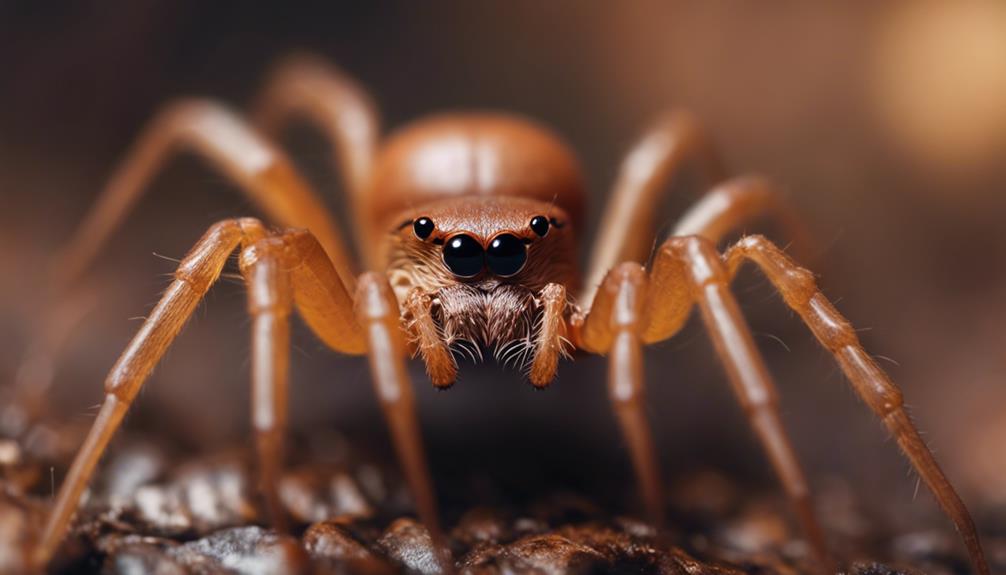
Nestled in the shadows of secluded spaces, the Brown Recluse Spider lurks with its venomous bite and distinctive violin-shaped marking. You may encounter this spider in dark, quiet areas like basements, closets, or woodpiles. Be cautious, as its venom can cause severe reactions in some individuals, leading to tissue damage and necrosis.
The Brown Recluse Spider’s secretive nature makes it challenging to spot, so always shake out clothing and shoes before wearing them, especially in regions where they’re prevalent. If bitten, seek medical attention promptly to prevent complications.
Brown Anole
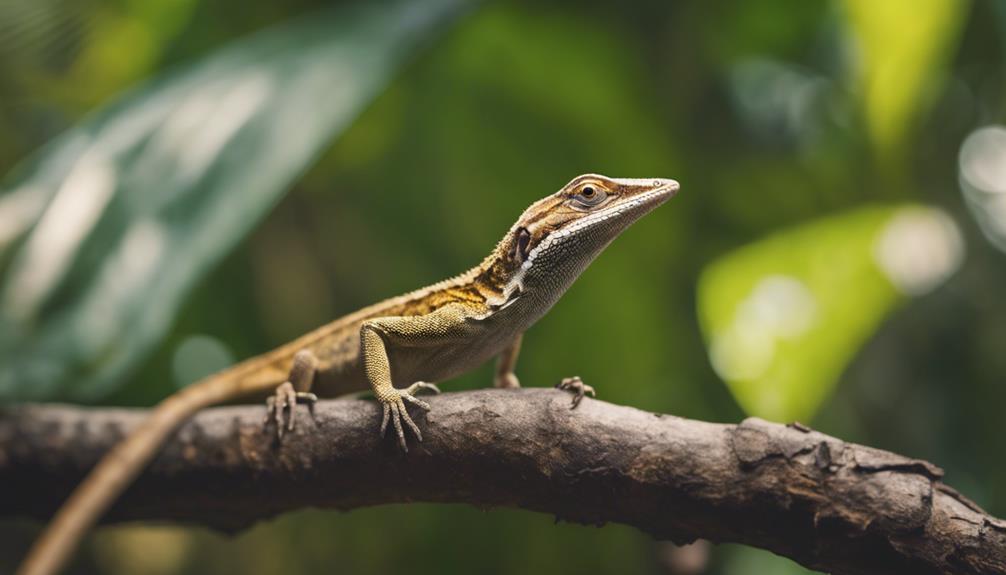
Safely observe the adaptable Brown Anole as it thrives in its natural habitat with remarkable agility and coloration. This small lizard, native to the southeastern United States and the Caribbean, is known for its ability to change color from brown to green, aiding in camouflage.
With slender bodies and long tails, Brown Anoles are expert climbers, using their toe pads to grip various surfaces. They’re diurnal creatures, often seen basking in the sun to regulate their body temperature.
Brown Anoles are opportunistic feeders, preying on insects like crickets, ants, and spiders. These lizards play an essential role in controlling insect populations, helping to maintain ecological balance in their habitats.
Due to their adaptable nature, Brown Anoles have successfully expanded their range beyond their native regions, becoming an invasive species in some areas. By observing and appreciating the Brown Anole’s resilience and unique characteristics, you can gain valuable insights into the importance of biodiversity and the delicate balance of ecosystems.
Brown Kiwi
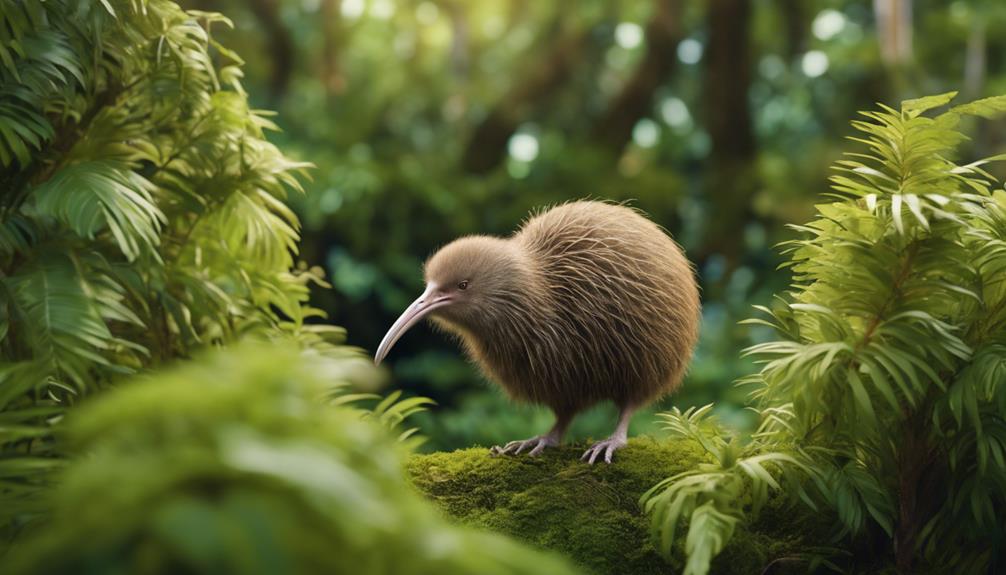
Amidst the dense foliage of New Zealand’s forests, the elusive Brown Kiwi emerges at dusk, its distinct call echoing through the wilderness. As you observe this unique bird, you’ll notice its fluffy brown feathers that help it blend seamlessly with the forest floor, providing excellent camouflage from predators. The Brown Kiwi, known for its long, slender bill ideal for probing the forest floor in search of insects and worms, plays an important role in maintaining the ecosystem’s balance.
These flightless birds aren’t only adept at foraging but also exhibit remarkable parenting skills. You might be surprised to learn that male Brown Kiwis are responsible for incubating the eggs and raising the chicks, showcasing a rare yet fascinating behavior in the avian world. Despite their nocturnal habits, encountering a Brown Kiwi in its natural habitat is a rewarding experience, underscoring the importance of conservation efforts to safeguard these remarkable creatures for future generations to admire.

Erzsebet Frey (Eli Frey) is an ecologist and online entrepreneur with a Master of Science in Ecology from the University of Belgrade. Originally from Serbia, she has lived in Sri Lanka since 2017. Eli has worked internationally in countries like Oman, Brazil, Germany, and Sri Lanka. In 2018, she expanded into SEO and blogging, completing courses from UC Davis and Edinburgh. Eli has founded multiple websites focused on biology, ecology, environmental science, sustainable and simple living, and outdoor activities. She enjoys creating nature and simple living videos on YouTube and participates in speleology, diving, and hiking.
- WILDLIFE THEMED T-SHIRTS
Cute Hedgehog Embroidered: Love Wildlife, Protect Nature Wildlife conservation tees
$35.00

